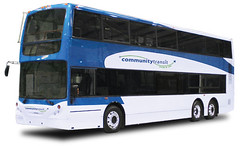A change the mobility paradigm is in order

Different transportation modes take up vastly different amounts of space. Image from Tampa via Denver.
One of the things I babble about is that the dominant planning paradigm is centered upon automobile connected separation of uses. The average household makes 15 trips/day, most in single occupancy vehicle trips. So if you build more roads, rather than work to make transportation and land use planning reciprocal, there is little you can do to reduce congestion, since the maximum capacity of a lane of road--in the best conditions of no stop lights and limited access--is 2,200 cars/hour.
It happens that 10% to 25% of trips are discretionary. So when people find negative inducements (congestion, etc.) they won't necessarily make the trip.
While it's true that business-to-busines delivery has different issues, as pointed out in this article, "Traffic Cure Only Worsens the Pain" in today's Post, at the same time, not rethinking delivery of freight, and special transportation demand management for deliveries, means that yes, the costs of congestion will increase.

Washington Post image by Marvin Joseph.
Shifting deliveries to night time when possible makes a big difference. For example, CVS stores mostly get deliveries during the day, and the big semi- truck and trailer combination makes traffic difficult. Were they to take deliveries at night, the impact on traffic would be minimal, except in a few locations.
In any case, rethinking logistics and delivery is necessary to truly impact congestion problems. We have a road network that is maximally used from 7 am to 7 pm, and then is empty for much of the time at the other hours. By time shifting some of that demand, maximum positive impact on throughput can occur.
In the city specifically, certain companies such as FedEx and UPS could save a lot of money by using delivery bicycles in the core of the city. It would mean more labor costs, but less money in vehicles, fuel and parking tickets.

UPS delivery bicycle, Germany. Image courtesy of Workcycles.
And by adding double deck buses to the Metrobus fleet, rather than more 40 feet and 60 feet long traditional buses, more capacity can be added without taking up more footprint on the street.

Community Transit photo, Snohomish County, Washington.
* Bus Model: Enviro 500
* Manufacturer: Alexander Dennis Limited
* Height: 14 ft
* Weight: 51,000 lbs
* Length: 40 ft
* Weight distribution: 70 percent of weight is contained just above floor level on the lower deck
* Capacity: 70 seats, with lower deck standing room for up to 20 passengers
* Hip-to-knee room: 31 inches
* Double deckers in U.S. transit: Las Vegas is the only other U.S. city with double decker buses in transit operation, although various cities are now testing.
But doing things the same old way is certain to not result in the kinds of systemic improvement that are needed.



0 Comments:
Post a Comment
<< Home